Cape Town International Airport
| Cape Town International Airport | |||
|---|---|---|---|
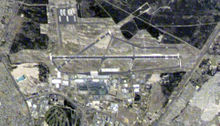 |
|||
| A satellite image of Cape Town International Airport | |||
| IATA: CPT – ICAO: FACT | |||
| Summary | |||
| Airport type | Public | ||
| Operator | Airports Company South Africa | ||
| Location | Cape Town, South Africa | ||
| Elevation AMSL | 46 m / 151 ft | ||
| Website | |||
| Runways | |||
| Direction | Length | Surface | |
| m | ft | ||
| 01/19 | 3,201 | 10,502 | Asphalt |
| 16/34 | 1,701 | 5,581 | Asphalt |
| Statistics (2008-2009) | |||
| Passenger traffic | 7,813,170 | ||
| Aircraft movements | 95,643 | ||
| Airport capacity (2010) | 14.5 million p.a. | ||
| Source: Airports Company South Africa[1][2] | |||
Cape Town International Airport is the primary airport serving the city of Cape Town, and is the second busiest airport in South Africa and third busiest in Africa. Located approximately 20 kilometres (12 mi) from the city centre, the airport was opened in 1954 to replace Cape Town's previous airport in the suburb of Wingfield. Cape Town International Airport is the only airport in the Cape Town metropolitan area that offers scheduled passenger services.
The airport has direct flights from South Africa's other two main urban areas, Johannesburg and Durban, as well as flights to smaller centres in South Africa. Internationally, it has direct flights to several destinations in Africa, Asia, Europe and South America. The air route between Cape Town and Johannesburg was the world's fifth busiest air route in 2007 as well as the busiest in Africa, with the air route between Cape Town and Durban being the fifth busiest in Africa.[3]
In 2009, Cape Town International Airport received the Skytrax award for the best airport in Africa.[4] The airport has domestic and international terminals, linked by a common central terminal.
Contents |
History
Cape Town International Airport was opened in 1954, a year after Jan Smuts Airport (now OR Tambo International Airport) on the Witwatersrand opened. The airport replaced Cape Town's previous airport, located at Wingfield. Originally called D.F. Malan Airport after the then South African prime minister, it initially offered two international flights: a direct flight to Britain and a second flight to Britain via Johannesburg.[5]
With the fall of apartheid in the early 1990s, ownership of the airport was transferred from the state to the newly-formed Airports Company South Africa,[6] and the airport was renamed to the politically-neutral Cape Town International Airport.[7] The first years of the twenty-first century saw tremendous growth at the airport; from handling 6.2 million passengers per annum in 2004-05, the airport peaked at 8.4 million passengers per annum in 2007-08 before falling back to 7.8 million in 2008-09.[1]
In preparation for the 2010 FIFA World Cup, Cape Town International Airport was extensively expanded and renovated. The main focus was the development of a Central Terminal Building at a cost of R1.6 billion,[8] which linked the formerly separate domestic and international terminals and provided a common check-in area.[9] The departures level of the Central Terminal opened in November 2009, with the entire building expected to be open in March 2010.[8]
Terminal information
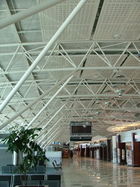
The terminal building has a split-level design, with departures located in the upper floors and arrivals in the lower floors; an elevated roadway system provides vehicular access to both departures and arrivals levels.[9] All check-in takes place within the Central Terminal Building, which contains 120 check-in desks and 20 self-service kiosks.[9] Passengers then pass through a consolidated security screening area before dividing, with international passengers heading north towards the international terminal (which contains immigration facilities), and domestic passengers heading south towards the domestic terminal.
The terminal contains 10 air bridges, evenly split between domestic and international usage. Sections of lower levels of the domestic and international terminals are used for transporting passengers via bus to and from remotely-parked aircraft.[9]
Arrivals are handled in the old sections of their respective terminals. Currently, arrivals are being redeveloped to utilise the new Central Terminal Building, with the new arrivals hall scheduled to open in March 2010.[8] The terminal contains an automated baggage handling system, capable of handling 30,000 bags per hour.[9]
Retail within the terminal building is located on the upper level above the departures level, which includes what is purported to be the largest Spur restaurant on the African continent, at 1,080 m2 (11,600 sq ft).[9] The terminal also has a viewing deck, located on the upper level.
In 2009, Cape Town International Airport was the recipient of the Skytrax "Best Airport in Africa" award, coming ahead of Durban International Airport and OR Tambo International Airport.[4]
Airlines and destinations
The following airlines operate scheduled flights to Cape Town International Airport:
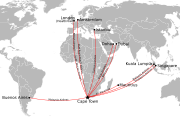
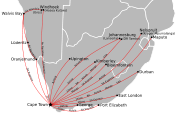
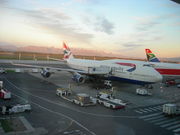
| Airlines | Destinations | Type |
|---|---|---|
| 1Time | Durban, East London, Johannesburg, Port Elizabeth | Domestic |
| Air Berlin | Munich [seasonal] | International |
| Air Mauritius | Mauritius | International |
| Air Namibia | Luderitz, Oranjemund, Walvis Bay, Windhoek-Eros, Windhoek-Hosea Kutako | International |
| Airlink | George, Kimberley, Nelspruit-Kruger Mpumalanga, Upington | Domestic |
| British Airways | London-Heathrow | International |
| British Airways operated by Comair | Durban, Johannesburg | Domestic |
| Emirates | Dubai | International |
| Etihad Airways | Abu Dhabi | International |
| Interlink Airlines | Pretoria-Wonderboom | Domestic |
| Lufthansa | Frankfurt [seasonal] | International |
| KLM | Amsterdam | International |
| Kulula.com | Durban, Johannesburg, Lanseria, Port Elizabeth | Domestic |
| Malaysia Airlines | Buenos Aires-Ezeiza, Kuala Lumpur | International |
| Mango | Bloemfontein, Durban, Johannesburg | Domestic |
| Qatar Airways | Doha | International |
| Singapore Airlines | Singapore | International |
| South African Airways | Durban, Johannesburg | Domestic |
| South African Airways | London-Heathrow | International |
| South African Express | Bloemfontein, East London, Port Elizabeth | Domestic |
| South African Express | Maputo, Walvis Bay, Windhoek-Hosea Kutako | International |
| TAAG Angola Airlines | Luanda | International |
| Turkish Airlines | Istanbul-Atatürk | International |
| Virgin Atlantic Airways | London-Heathrow [seasonal] | International |
Other facilities
The only hotel located within the airport precinct is the budget Road Lodge, owned by the City Lodge hotel chain group. An ExecuJet facility is located near the southern end of the main runway, and caters for business jets.
Traffic and statistics
Cape Town International Airport recorded 7.8 million passengers in 2008-2009, down from 8.4 million passengers the year before. Of those passengers, 1.4 million were international and 6.3 million domestic, with the remainder being classified as "regional" or "unscheduled". 95,643 aircraft traffic movements were recorded; the majority being domestic services. The statistics firmly entrench Cape Town International Airport as being the second busiest airport in South Africa, behind OR Tambo International Airport in Johannesburg and ahead of Durban International Airport.[10]
| Year | International | Regional | Domestic | Unscheduled | Total | |||||
|---|---|---|---|---|---|---|---|---|---|---|
| Passenger movements | % Change | Passenger movements | % Change | Passenger movements | % Change | Passenger movements | % Change | Passenger movements | % Change | |
| 2004-05 | 1,176,958 | no data | 126,837 | no data | 4,895,048 | no data | 16,060 | no data | 6,214,903 | no data |
| 2005-06 | 1,167,661 | 149,489 | 5,503,690 | 13,333 | 6,834,173 | |||||
| 2006-07 | 1,246,016 | 147,885 | 6,107,405 | 17,237 | 7,518,543 | |||||
| 2007-08 | 1,309,822 | 145,858 | 6,950,061 | 20,877 | 8,426,618 | |||||
| 2008-09 | 1,378,160 | 138,000 | 6,283,132 | 13,878 | 7,813,170 | |||||
| Year | International | Regional | Domestic | Unscheduled | Total | |||||
|---|---|---|---|---|---|---|---|---|---|---|
| Aircraft movements | % Change | Aircraft movements | % Change | Aircraft movements | % Change | Aircraft movements | % Change | Aircraft movements | % Change | |
| 2004-05 | 4,355 | no data | 4,242 | no data | 56,810 | no data | 27,154 | no data | 92,561 | no data |
| 2005-06 | 4,296 | 4,169 | 58,099 | 22,326 | 88,890 | |||||
| 2006-07 | 4,623 | 3,698 | 60,470 | 22,602 | 91,393 | |||||
| 2007-08 | 5,019 | 3,420 | 69,819 | 24,027 | 102,285 | |||||
| 2008-09 | 5,638 | 3,340 | 65,623 | 21,042 | 95,643 | |||||
Access
Car

Cape Town International Airport is approximately 20 kilometres (12 mi) from the city centre and is accessible from the N2 freeway, with Airport Approach Road providing a direct link between the N2 (at exit 16) and the airport. The airport can also be indirectly accessed from the R300 freeway via the M12, M10 and M22.
The airport provides approximately 1,424 parking bays in the general parking area, and 1,748 parking bays in the multi-storey parkade located near the domestic terminal.[11] A new parkade, which is located near the international terminal and which will provide an additional 4,000 bays upon completion, is under construction and is scheduled to be completed in March 2010.[12] The airport also offers a valet parking service.[11]
Public transport
The MyCiTi bus rapid transit system provides a shuttle service connecting the airport with the Civic Centre bus station in the city centre. Buses depart every 20 minutes from 04:20 to 22:00.[13] Transport to and from the airport is also provided by metered taxis and various private shuttle companies.[7]
Rail link
There is no direct rail access to Cape Town International Airport. The Passenger Rail Agency of South Africa has proposed a 4 km (2.5 mi) rail link between the airport and Cape Town's existing suburban rail network; it is however unlikely that the rail link will be constructed before the 2011 completion of the Gautrain project in Gauteng.[14]
Accidents and incidents
- On 26 May 1971, three South African Air Force Hawker-Siddelley HS125 aircraft, practising for a fly past for an upcoming air show at the airport, crashed into Devil's Peak just west of the airfield. The aircraft were destroyed and all 11 crew were killed.[15][16]
- On 5 June 1983 a Cessna 402B, tail number ZS-KVG, crashed shortly after take-off in inclement weather. Seven out of the nine on board were killed. It transpired that the pilot did not have an instrument rating and had falsified his logbook in order to hire the aircraft.[15][17][18]
- On 7 November 2007, a Boeing 737-230, ZS-OEZ, operated by Nationwide Airlines suffered complete separation of the right (starboard) engine at take-off. The take-off was continued and the crew successfully landed the aircraft without injury or loss of life. The aircraft had 106 passengers on board.[19]
Aeronautical information
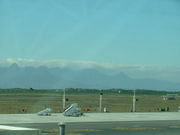
The following is an example of information required by aircrew to operate at this airport. Such information is usually found on approach plates and is also disseminated by means of NOTAMs (NOtices To AirMen) and other publications. All information is sourced from the South African Civil Aviation Authority.[20]
| Type | Identification | Frequency |
|---|---|---|
| NDB | CB | 462.5 |
| VOR/DME | CTV | 115.7 |
| ILS LOC RWY 01 | CTI | 110.3 |
| ILS LOC RWY 19 | KNI | 109.1 |
Communication
- Communication Frequencies
- Cape Town Apron 122.65 MHz
- Surface Movement Control 121.90 MHz
- Cape Town Tower 118.10 MHz
- Cape Town Approach 119.7 MHz
- Automatic Terminal Information Service - 127.00 MHz
Notes
- Magnetic variation 25W
- Do not confuse THR 16 for THR 19 when taxiing on TWY A1 for take-off on RWY 19.
- Avoid overflying Tygerberg Hospital - 3NM North of AD, when taking-off from RWY 01 & 34.
- Standard Terminal Arrival Routes (STARs) are published for this airport.
Future development
Apart from completion of the 2010 expansion project, it has been proposed that a second runway for large aircraft be constructed at Cape Town International Airport. An expected date for construction of the second runway has yet to be determined.[21]
See also
- List of airports in South Africa
- List of South African airports by passenger movements
References
- ↑ 1.0 1.1 1.2 "ACSA - Cape Town Passenger Statistics". Airports Company South Africa. http://www.acsa.co.za/home.asp?pid=137. Retrieved December 28, 2009.
- ↑ 2.0 2.1 "ACSA - Cape Town Aircraft Statistics". Airports Company South Africa. http://www.acsa.co.za/home.asp?pid=139. Retrieved December 28, 2009.
- ↑ "OAG reveals latest industry intelligence on the busiest routes". OAG. http://www.oag.com/oag/website/com/en/PopUps/Print/Press+Releases/OAG+reveals+latest+industry+intelligence+on+the+busiest+routes+2109072. Retrieved December 26, 2009.
- ↑ 4.0 4.1 "World Airport Awards 2009 - Regional Results". Skytrax. http://www.worldairportawards.com/Awards_2009/ResultsFull.htm. Retrieved December 28, 2009.
- ↑ Bickford-Smith, Vivian; E. Van Heyningen, Nigel Worden (1999). Cape Town in the twentieth century: an illustrated social history. Cape Town: New Africa Books. p. 120. ISBN 9780864863843. http://books.google.co.za/books?id=SkxmcdhpPbMC&printsec=frontcover&source=gbs_navlinks_s#v=onepage&q=&f=false. Retrieved December 28, 2009.
- ↑ "ACSA - History". Airports Company South Africa. http://www.acsa.co.za/home.asp?pid=67. Retrieved December 28, 2009.
- ↑ 7.0 7.1 "Cape Town Airport (CPT) Information - Airports Guide to Cape Town". airports-guides.com. http://cape-town-cpt.airports-guides.com/. Retrieved December 28, 2009.
- ↑ 8.0 8.1 8.2 Nicholson, Zara (November 8, 2009). "New terminal hailed as a success". Sunday Argus (IOL). http://www.iol.co.za/index.php?set_id=1&click_id=13&art_id=vn20091108075550577C968736. Retrieved December 28, 2009.
- ↑ 9.0 9.1 9.2 9.3 9.4 9.5 "ACSA - New Developments". Airports Company South Africa. http://www.acsa.co.za/home.asp?pid=3785. Retrieved December 28, 2009.
- ↑ "ACSA - Statistics". Airports Company South Africa. http://www.acsa.co.za/home.asp?pid=100. Retrieved December 28, 2009.
- ↑ 11.0 11.1 "ACSA - Cape Town - Maps and parking". Airports Company South Africa. http://www.acsa.co.za/home.asp?pid=3637. Retrieved December 28, 2009.
- ↑ "More parking comes online at Cape Town International Airport". Airports Company South Africa. December 10, 2009. http://www.acsa.co.za/home.asp?pid=94&toolid=2&itemid=6386. Retrieved December 28, 2009.
- ↑ "Last ‘Free Friday’ for MyCiti inner city loop…for a while". City of Cape Town. http://www.capetown.gov.za/en/Pages/LastFreeFridayforMyCitiinnercityloopforawhile.aspx. Retrieved July 17, 2010.
- ↑ Peters, Melanie (June 14, 2008). "Joining the dots between city-airport rail". Cape Argus (IOL). http://www.iol.co.za/index.php?set_id=1&click_id=13&art_id=vn20080614090105146C603502. Retrieved December 28, 2009.
- ↑ 15.0 15.1 Byrom, James (1993). Fields of Air. Ashanti Publishing. ISBN 01919874127.
- ↑ "Accident Details - May 26, 1971". planecrashinfo.com. http://planecrashinfo.com/1971/1971.htm. Retrieved December 28, 2009.
- ↑ "Accident Details - June 5, 1983". planecrashinfo.com. http://planecrashinfo.com/1983/1983-24.htm. Retrieved December 28, 2009.
- ↑ "ASN Aircraft accident 05-JUN-1983 Cessna 402 ZS-KVG". Aviation Safety Network. http://aviation-safety.net/wikibase/wiki.php?id=19533. Retrieved December 28, 2009.
- ↑ "ASN Aircraft accident Boeing 737-230 ZS-OEZ Cape Town International Airport (CPT)". Aviation Safety Network. http://aviation-safety.net/database/record.php?id=20071107-0. Retrieved December 28, 2009.
- ↑ "CAA Website". South African Civil Aviation Authority. http://www.caa.co.za/. Retrieved December 26, 2009.
- ↑ "Cape Town airport may get second runway". IOL. January 25, 2002. http://www.iol.co.za/index.php?sf=124&set_id=1&click_id=13&art_id=ct20020125101000823B510966. Retrieved December 28, 2009.
External links
|
|||||
|
|||||